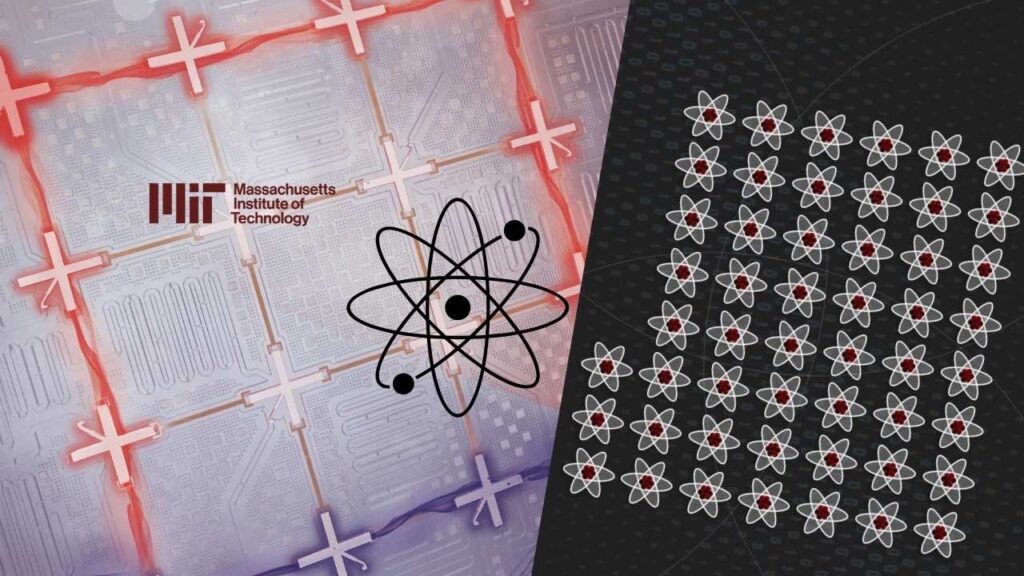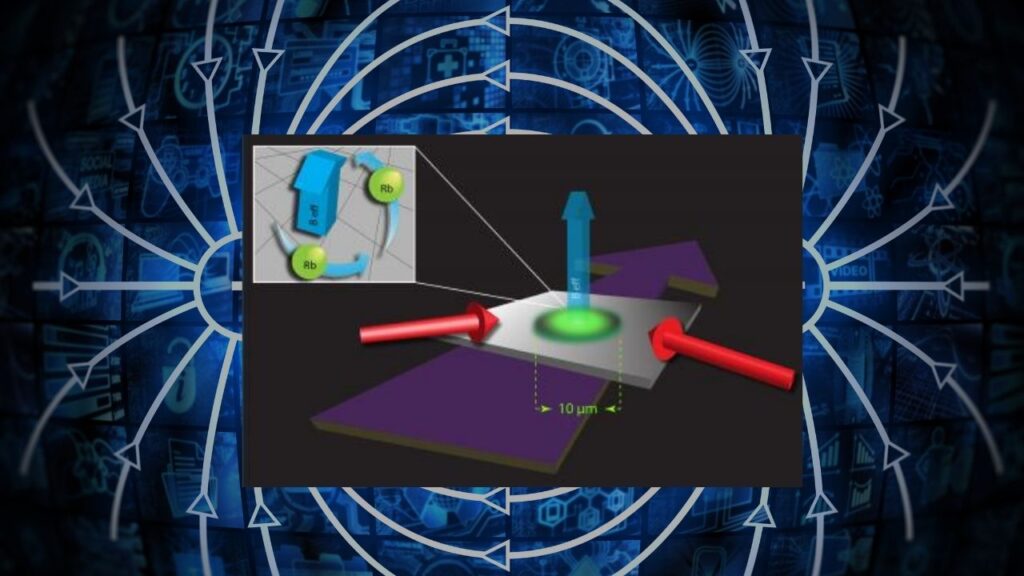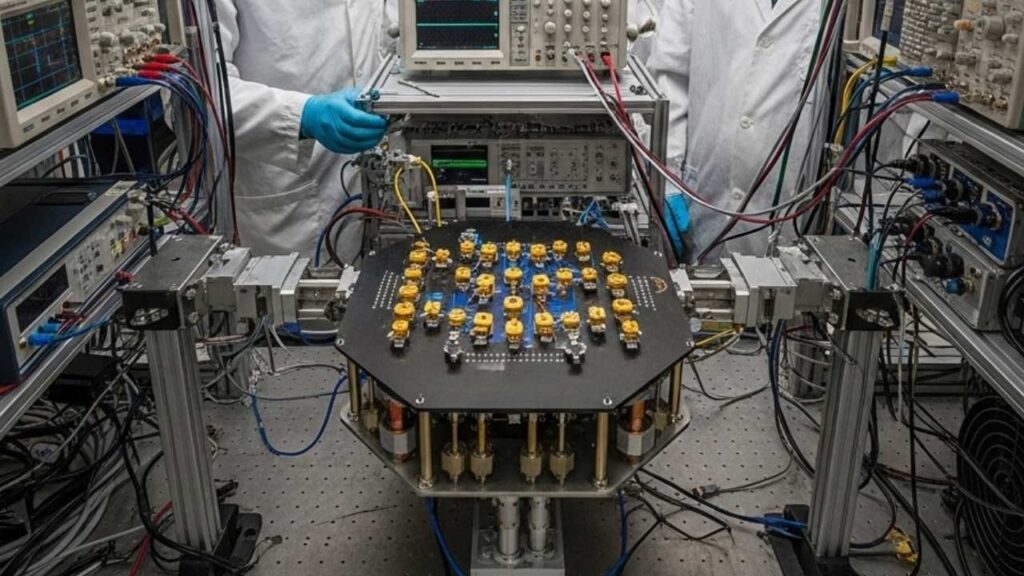MIT Demonstrates Quantum Simulator: MIT has taken a groundbreaking leap in quantum technology by demonstrating a quantum simulator with adjustable synthetic magnetic fields. This innovation could transform how scientists study quantum materials, develop new types of electronics, and even emulate physical forces in a lab-controlled setting. It’s a big win for both theoretical physics and practical computing.

The research, published in Nature Physics, showcases a 16-qubit superconducting quantum simulator that allows precise manipulation of synthetic electromagnetic fields. These artificial fields behave like real magnetic and electric fields but are generated inside the quantum device, opening new doors to simulate exotic physical environments.
Understanding and controlling electromagnetic fields at the quantum level is crucial for advancing quantum computing, materials science, and fundamental physics. Traditional computers struggle to model the complex interactions of electrons in strong magnetic fields, especially in exotic materials with unique electronic properties. MIT’s new platform provides a versatile, highly controllable testbed that can simulate these challenging environments with unprecedented precision.
MIT Demonstrates Quantum Simulator
| Feature | Details |
|---|---|
| Innovation | 16-qubit superconducting quantum simulator with synthetic magnetic and electric fields |
| Technology | Superconducting transmon qubits with tunable microwave modulation |
| Published In | Nature Physics (https://www.nature.com/articles/s41567-024-02520-9) |
| Synthetic Fields | Time-varying vector potentials simulate real electromagnetic forces |
| Applications | Simulating quantum materials, topological phases, and electron dynamics |
| Institution | Massachusetts Institute of Technology (MIT) (https://www.mit.edu) |
| Funding | DOE, DARPA, NSF |
MIT’s demonstration of a quantum simulator with adjustable synthetic magnetic fields marks a major milestone in quantum research. It provides a powerful new platform for simulating electromagnetic phenomena on a quantum scale, enabling discovery and innovation in quantum materials, topological electronics, and quantum computing.
By combining scalability, tunability, and precise control, this technology helps scientists see and manipulate the quantum world in ways previously impossible. As it scales, it promises to unlock deeper understanding and new technologies that harness quantum effects for real-world applications.
What Is a Quantum Simulator?
Imagine trying to understand how electrons behave in a complex material like graphene or a superconductor. It’s extremely hard to do with traditional computers because the quantum behavior of particles becomes too complex to calculate. Quantum mechanics allows particles to exist in many states at once and exhibit entanglement, making simulations exponentially difficult as system size grows.
A quantum simulator is like a mini-laboratory built with qubits (quantum bits). It mimics the laws of quantum physics so we can observe and study things that are usually hidden or too small to examine directly. Unlike a universal quantum computer—which aims to solve a wide variety of problems—a quantum simulator focuses on specific physics models and quantum phenomena, allowing scientists to explore quantum materials and particle behaviors directly.
In this case, MIT’s team used 16 superconducting transmon qubits—tiny circuits cooled to near absolute zero—to simulate how particles move under artificial electromagnetic forces. These qubits are fabricated on a chip and are interconnected to allow photons (quantum particles of light) to “hop” between them, mimicking how electrons move in a lattice.
Why Synthetic Magnetic Fields Matter
In the real world, magnetic fields guide how electrons travel through materials. They can cause electrons to bend paths, create quantum Hall effects, and influence conductivity and other electronic properties. If you can simulate these fields precisely in a lab, you can:
- Discover new types of quantum materials with novel electrical, magnetic, or optical properties.
- Study the Quantum Hall Effect, where electrons move in a way that generates quantized conductance, crucial for next-generation electronics.
- Understand how electrons behave in extreme conditions that are difficult to recreate physically, like very strong or time-dependent magnetic fields.

However, applying real magnetic fields at the quantum scale is messy, limited by hardware, and can interfere with the delicate quantum states of the device. Synthetic magnetic fields overcome these challenges by creating artificial gauge fields through controlled interactions within the quantum device itself.
MIT researchers used a clever trick: microwave signals with precisely tuned frequencies and phases create Peierls phases on photons hopping between qubits. This effectively simulates a magnetic vector potential—a fundamental concept in electromagnetism—across their qubit lattice. This lets them dial in field strengths, directions, and even time variations, creating conditions impossible with natural magnets.
This flexibility means researchers can explore many different physical regimes without redesigning the hardware, accelerating discovery and experimentation.
How the Technology Works
Step 1: Build a Grid of Qubits
MIT’s team arranged 16 qubits into a 4×4 square lattice. Each qubit is a superconducting transmon circuit, cooled near absolute zero (around 10 millikelvin) to preserve quantum coherence—the delicate quantum states necessary for simulation.
Step 2: Apply Modulated Microwave Signals
Microwave signals are applied to each qubit with carefully controlled frequencies and phases. These microwaves modulate the energy levels of the qubits periodically.
This modulation causes photons to hop between neighboring qubits, similar to how electrons jump between atoms in a material. By adjusting the timing (phase) of these modulations, the hopping gains a complex phase factor—the synthetic magnetic vector potential.
Step 3: Break Time-Reversal Symmetry
Normally, quantum hopping is time-reversal symmetric, meaning particles behave the same if time runs backward. To simulate a magnetic field, this symmetry must be broken. MIT researchers achieved this by tuning the modulation phases such that particles hopping clockwise experience different phases than counterclockwise, mimicking the effect of a real magnetic field on charged particles.
Step 4: Observe Emergent Phenomena
The team observed several hallmark effects:
- Aharonov-Bohm interference: Quantum interference patterns showing particles are influenced by magnetic potentials, even in regions with no magnetic field directly present.
- Bloch oscillations: Oscillations of quantum particles in a periodic potential under an applied synthetic electric field, similar to electrons in crystals under electric bias.
- Hall deflection: The quantum and classical Hall effect analogs, where particles curve transversely due to the combined synthetic magnetic and electric fields.

These results validate that the simulator accurately reproduces electromagnetic physics at the quantum scale.
Real-World Applications
1. Materials Discovery
Simulating complex quantum materials before synthesizing them in the lab saves considerable time and expense. This quantum simulator can model materials with strong electron interactions, disorder, or topological properties that classical computers struggle to handle. The insights gained can help design better batteries, superconductors, or semiconductors.
2. Topological Electronics
Topological materials are at the frontier of condensed matter physics because of their robustness against defects and their unique edge states conducting electricity with little loss. They hold promise for future quantum computing devices and low-power electronics. MIT’s platform allows detailed study of these materials’ quantum behaviors, accelerating innovation.
3. Quantum Information Processing
Understanding how synthetic gauge fields affect quantum particles helps improve quantum computing architectures, especially in error correction and qubit connectivity. These insights support the broader quantum computing ecosystem by enabling more robust, scalable quantum machines.
4. Education and Fundamental Science
This quantum simulator provides a hands-on system to visualize and experiment with complex quantum phenomena, fostering better education and training for the next generation of quantum scientists and engineers.
The MIT Advantage
MIT’s quantum simulator stands out for combining scalability, tunability, and precision. Previous platforms often had limited qubit counts or fixed synthetic fields. Here’s why MIT’s design is unique:
- Large 16-qubit grid allows exploration of multi-particle phenomena and lattice-wide effects.
- Adjustable synthetic fields let field strength and orientation be continuously tuned without hardware changes.
- Single-qubit addressability enables individual qubits to be measured and controlled, offering detailed system diagnostics.
- High coherence times mean qubits maintain quantum states long enough for complex simulations.
- Integration with classical controls uses state-of-the-art electronics developed at MIT.
The project was developed by MIT’s Engineering Quantum Systems (EQuS) group, with funding from the Department of Energy (DOE), Defense Advanced Research Projects Agency (DARPA), and National Science Foundation (NSF).
Physicists Create One of the Most Neutron-Deficient Isotopes Ever Observed in the Lab
Attosecond ‘Clock’ Measures Electron Tunneling Time With Unmatched Precision
FAQs About MIT Demonstrates Quantum Simulator
What is the difference between a quantum computer and a quantum simulator?
A quantum computer is a universal device capable of solving many types of computational problems using quantum algorithms. A quantum simulator is specialized hardware designed to model particular quantum systems or phenomena, such as electrons in a lattice or spins in a magnetic field. Simulators are often easier to build and can yield practical physics insights faster.
Can synthetic magnetic fields replace real magnets?
Synthetic magnetic fields are not substitutes for real magnets in everyday applications. They are artificial constructs inside quantum devices used primarily for research and simulation. Their advantage is in offering highly precise, tunable, and complex field configurations impossible with physical magnets.
How big is MIT’s simulator?
It currently features 16 qubits arranged in a 4×4 grid, with each qubit being a superconducting transmon circuit cooled to millikelvin temperatures.
What’s next for this technology?
Researchers plan to scale to larger arrays of qubits (50+), allowing simulations of more complex quantum materials and novel synthetic gauge fields. This could enable studies of phenomena such as fractional quantum Hall effects and synthetic dimensions.






